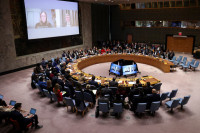Columns
Nepal does need to focus on economic growth, but not at the cost of a better quality of life for all
It is better to have an evenly distributed low per capita income without people living in the slums..jpg&w=900&height=601)
Jagadish Prasad Bist
Right from his taking office, Prime Minister KP Oli has been adamantly promoting the motto 'Prosperous Nepal, Happy Nepali'. In line with this slogan, the National Planning Commission envisioned a 10.3 percent growth by the fiscal year 2023-24 under its 15th five-year plan. In fact, if there is any topic that has been debated extensively since Oli assumed office, it is gross domestic product (GDP) growth. The government targeted a growth rate of 8.5 percent in 2019-20, but the World Bank projected it to be around 7 percent. The opposition is clamouring that the government failed to achieve its target, while the government insists that a growth rate of more than 6 percent is taken as rapid economic activities in the country.
GDP growth has been promoted in a way that seems to show that it is the only way to prosperity. But GDP growth rate does not indicate the overall well-being of a country and achieving growth targets does not necessarily lead to prosperity either. Classical economic theory defines GDP as the total monetary value of all the goods and services produced within a country in a year. The modern definition was proposed by John Maynard Keynes after the Second World War as the sum of private consumption, investment and government spending. GDP growth is a static value that tells you how the monetary value of the products and services (excluding digital or virtual ones) is changing over a period of time. Therefore, focusing only on GDP growth should not be a major policy target of a country.
Individual well-being
The argument is not whether a developing country like Nepal should worry about GDP or not. Of course, it should. But the argument is that equal importance should be given to the externalities of economic growth on society, such as climate change and income inequality. For example, Nepal has to learn a lot from the development activities of its neighbours, China and India. They have been changing their priorities from a GDP-focused economy to individual well-being. It is important to note that if GDP measures everything, the second-largest economy in the world, China, would not be purchasing cans of fresh air from Canada and other countries. To overcome such issues, China is investing heavily in green city projects.
And if the GDP accounts for everything, the fifth largest economy in the world, India, may not be worried about people in its major cities breathing freely or about people sleeping on the streets. It is reported that 78 million people in India, more than three times Nepal's entire population, live in slums. Viewing Chinese and Indian development in hindsight shows us that climate issues and income inequality are the major areas where the policy focus on GDP growth is short-sighted.
But Nepal does not seem to be giving much attention to these factors. Development activities in the Kathmandu Valley, for instance, are chaotic. Delays in road construction and expansion not only show how the government’s intentions are misplaced, but the pollution from haphazard development pose significant health issues in the Valley’s residents. The management of waste has also been a consistent headache for the Nepal government. A more worrying fact is that the Ministry of Health has not even tried to calculate the economic cost of health issues caused by polluted air in the Valley due to such development activities. Nepal's long-term policies are industrial sector friendly, but they do not bother about their climate issues. The government’s failure to take into account climate issues related to the proposed Nijgadh international airport is just an example.
Countries with a large GDP are making issues of income inequality a priority. Statistics show that South Africa, China, India, South Korea and the US have a high Gini coefficient, which is an indicator of income inequality. Their priority now is to reduce this gap and build an equitable society. For this, India has started measuring and focusing on Ease of Living Index for its citizens’ quality of life. Therefore, a country like Nepal, which has extant literature on development and its externalities from the developed and fast-developing countries' experiences, should focus more on tackling the negative effects on climate, society and the overall well-being of the people instead of being fixated on GDP growth.
Climate-friendly development
Setting a high GDP growth target and promoting industrial development should, without doubt, be priorities for Nepal to get out of its low-income status. But the development needs to be climate-friendly and sustainable. This means that development activities and the mitigation of their externalities have to go hand in hand. Nepal has to put more emphasis on giving equal opportunities to each and every citizen to enjoy the benefits of development. Rather than chasing growth targets, the country should be reducing the income gap between the people. In the end, it is better to have an evenly distributed low per capita income without people living in slums than a high per capita with income concentrated among a handful of people and a majority living in slums.
More importantly, before formulating any development policy, its adverse effects on climate change and social well-being should be taken more seriously than its actual economic benefit. Otherwise, the motto 'Prosperous Nepal, Happy Nepali' will only remain on paper.
***
What do you think?
Dear reader, we’d like to hear from you. We regularly publish letters to the editor on contemporary issues or direct responses to something the Post has recently published. Please send your letters to [email protected] with "Letter to the Editor" in the subject line. Please include your name, location, and a contact address so one of our editors can reach out to you.




 6.84°C Kathmandu
6.84°C Kathmandu.jpg)















